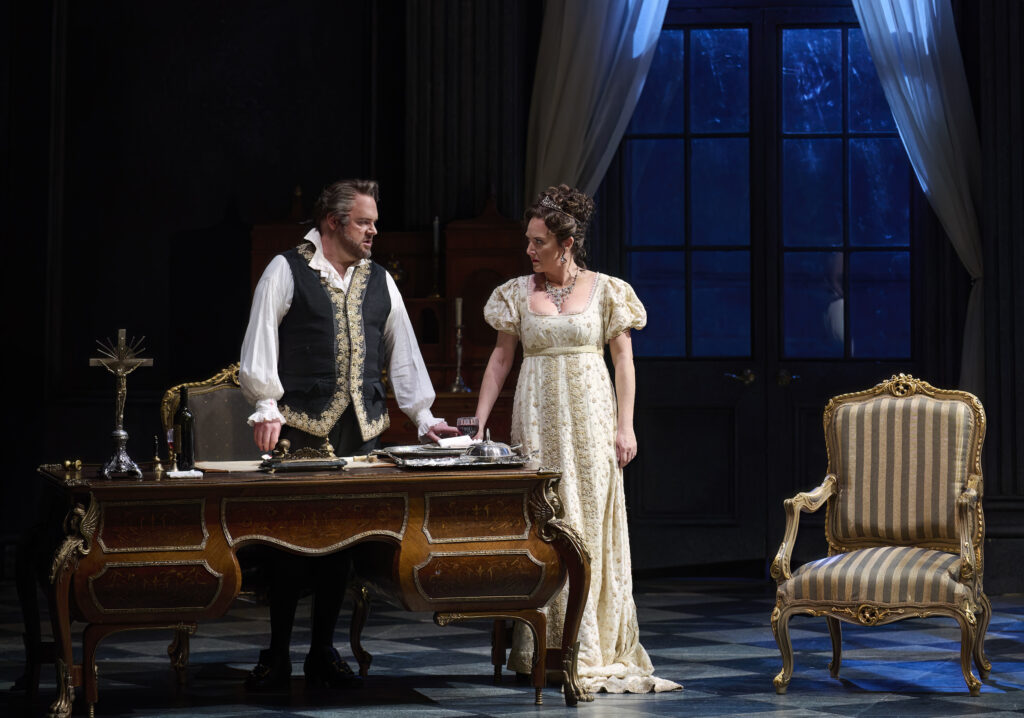Tosca, Giacomo Puccini’s sizzling verismo thriller first presented on January 14, 1900 in Rome, is the product of two distinct impulses — one creative, the other historical. A sharply observed adaptation of a rambling 5-act turn of the century melodrama by popular French playwright Victorien Sardou, Puccini’s opera, for all its musical sweep and grandeur, is a masterpiece of narrative compression. A mere three characters power story — Floria Tosca, a beautiful celebrated singer, much in demand in Italian aristocratic circles; Mario Cavaradossi, a bohemian artist with pronounced anti-establishment sympathies and Baron Vitellio Scarpia, ruthless Chief of Police — all arrayed against a sweeping backdrop of Continental turmoil and tumultuous socio-political change.
Rome. June 1800.
Italy, long a fragmented assortment of petty principalities and insular duchies largely presided over by Austria, is overrun by an invincible, 25,000-man Revolutionary army commanded by Napoleon Bonaparte in the summer of 1798. Rome, capital of the Papal States, falls. The Pope is exiled. A republican government is installed overseen by seven consuls. The French-appointed administration, its fervent championing of universal human rights a core doctrine, will prevail for all of 20 months. Encouraged by the Church, the forces of reaction soon crush the experiment.
Momentarily diverted by his obsessive campaign in Egypt, Napoleon returns to the Italian peninsula in 1800 to face the overwhelmingly superior might of a combined Austro-Russian force supported by Queen Marie Caroline of Naples, a steely Habsburg princess with a pathological abhorrence of any and all revolutionary precepts. The brutal fate of her sister, Marie Antoinette, forever scars her consciousness.
Napoleon rashly divides his army and is compelled to surrender to the Austrians near Milan on June 4. The battlefield would not fall silent for long. Reinforcements arrive. The French troops are revitalised. Napoleon is victorious at the Battle of Marengo.
Panicked to the point of paranoia, Queen Marie Caroline orders her enablers in Rome to embark on a vindictive campaign of bloody reprisals, snaring and executing any and all republican sympathizers before fleeing to Palermo where Lord Nelson holds sway.
The first faint drafts of the Risorgimento drift through the streets of Rome. Puccini and librettists Luigi Illica and Giuseppe Giacosa fan history into a swirling, mythic expression of Italian resistance and independence, bona fide, early 19th century history sparking a good deal of the almost documentary-accented action. Napoleon’s changeable fate is persistently reported, on stage operatic conflict triggered.
Wrapping a tentative season of primarily venerable remounts, the Canadian Opera Company fills the Four Seasons Centre to overflowing with the rapturous music and impassioned scena that is Italian Grand Opera’s grandest late 19th century creation. Premiered in 2008, reprised in 2012, staged again in 2017, director Paul Curran’s sumptuous Tosca, a monument to theatrical splendour, still generates copious amounts of energy and power, Illica and Giacosa’s depiction of tyranny defied, vividly on show, arguably more demonstrably than ever.
There is an undeniable ring of authenticity to Curran’s handling of Tosca here reaching far beyond the parade of lavish clerical vestments on display in the soaring Basilica of Sant’Andrea della Valle. Or the snappy Napoleonic era uniforms of the riflemen summoned to the ramparts of the Castel Sant’Angelo. Or indeed the massive church itself. Or the forbidding castle. Set and costume design courtesy Kevin Knight is impeccably period informed. A feast for the eyes. But however delectable, this is not the main course.
A genuineness of emotion, a clarity and brightness of characterization — Curran delves deep into the drama, the weight of far-reaching, multinational politics impacting principals and comprimari alike.
Tosca, commandingly sung and acted by soprano Sinéad Campbell-Wallace, beats off the odious advances of the detestable Scarpia with impressive ferocity. Vissi d’arte, vissi d’amore/non feci mai male ad anima viva (“I have lived for art. I have lived for love./I have never harmed a living soul.”). It is not enough. No amount of benevolence can shield her from fate, a fact Campbell-Wallace makes abundantly clear with a lowering of the shoulders, a quick gulp of red wine, a gathering emptiness behind the eyes.
British baritone Roland Wood delivers a particularly chilling rendition of Rome’s vicious enforcer of the crumbling monarchial status quo, his every move calculated and precise, his singing pure liquid evil. Cold-blooded, icily focused, this Scarpia is less a monster, more a machine, his secret torture chamber the product of a morally featureless mind. A technocrat. A bureaucratic predator. Bramo. La cosa bramata perseguo,/me ne sazio e via la getto. (“I am gripped by desire. I pursue what I want,/take my fill and throw it away.”) Sex is weaponized. Scarpia’s murder at the hands of a frenzied Tosca elicits no feeling of catharsis. The pall of suffering and depravity that overhangs his ghastly lair in the Palazzo Farnese is too impenetrable. Curran offers us no refuge. No release.
Appearing as Cavaradossi, tenor Stefano La Colla endows Puccini’s emblem of indestructible resolve with boundless humanity, nowhere more abundantly manifest than in the excruciatingly taut execution scene that occupies the entirety of Act III. Uncomfortably seated astride a simple wooden bench, Cavaradossi desperately searches for words that will not come to express his immeasurable love for Tosca. A subtle hint of frustration as La Colla gazes skyward. Puccini’s great glowing aria, E lucevan le stelle (“And the stars would be shining”) pours from his soul. His jailer (Alex Halliday) approaches. A ring, hastily traded for paper, pen and ink, is touchingly returned, a small, brilliantly illuminated gesture of compassion in a production packed with nuance.
Cesare Angelotti, ex-consul of Rome, (Christian Pursell) staggering with exhaustion, head bowed, stumbling — a hunted man on the run.
A cranky sacristan (Donato Di Stefano) cursing Cavaradossi under his breath. Ma con quei cani di volteriani/nemici del santissimo governo/nonc’è da metter voce (“But there’s no reasoning/with these Voltairean dogs,/enemies of the Holy See”) amid much crossing and recrossing of self.
Scarpia’s henchmen, Spoleta and Sciarrone, (Michael Colvin and Giles Tomkins) cowering with fear, neither able to summon the courage to confront their diabolical employer with bad news.
Curran’s Tosca thrives on detail.
Sound painting with a series of carefully chosen orchestral brushes, Puccini evokes a world of startling sonic dimension. The towering Te Deum that closes Act I — a robust hymn of thanks celebrating the expulsion of the French occupying force and subsequent restoration of the Papacy — is a triumph, not only of harmony, but compelling acoustical effects, as well. Marrying Scarpia’s sinister Va’, Tosca!/Nel tuo cor s’annida Scarpia! (“Go, Tosca!/Scarpia is nesting in your heart”) to the mighty choral uplift of the liturgy, Puccini unleashes a tidal wave of sound complete with organ, church bells and cannon fire announcing Angelotti’s escape from prison.
Motifs representing any number of intense emotional states and/or pivotal characters are similarly vibrant, the celebrated — or perhaps notorious — dissonant tritone, the “devil’s interval” as it was traditionally known, that opens the opera is frequently heard to chilling effect in association with all matters hellish and bloody.
The Canadian Opera Company Chorus makes a single, stirring cameo appearance as the exceptionally potent mass choir of Sant’Andrea. Visiting conductor Giuliano Carella leads a hyper-charged COC Orchestra. Woodwinds and brasses are particularly well-voiced. Percussion is heart-stopping.
Tyranny. Terror. The torture state. The triple threat of oppression still lives among us. Tosca both explicates and warns, a dynamic cast of urgent voices ringing down the ages.


